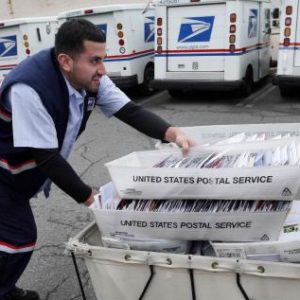Editor’s Note: For another viewpoint, see Counterpoint: We Need Postal Service Now More Than Ever
The Postal Service — for which leading House Democrats and postal unions are using the COVID-19 crisis to raise fears of an imminent postal collapse — demanded $89 billion in unrestricted federal grants and loans, and is using its supposed looming downfall to beat up the Trump administration.
The situation underscores what is wrong in Washington with the issuance of blank checks instead of solving problems through practical means and compromise.
Unlike many small businesses, healthcare providers and local governments, the Postal Service’s finances have long been a mess. Beginning in 2009, the Government Accountability Office had the Postal Service on its High-Risk List of government agencies.
At the end of fiscal year 2019, the Postal Service recorded its 13th consecutive annual loss, reported a negative net worth of $71 billion and its unfunded liabilities exceeded $140 billion.
On April 9, the Postal Service made its audacious ask for $89 billion in grants and loans.
This is 125 percent of its 2019 revenues. The request came less than two weeks after President Trump signed the CARES Act, which included $10 billion in additional borrowing authority for the Postal Service.
The Postal Service is taking a hit from COVID-19. Its mail volume is down about 30 percent, but its package business is up sharply, though the Postal Service has not revealed those numbers.
The Postal Service has put forward nothing to justify the $89 billion. The only public information was in an April 9 press release from the U.S. House of Representatives Oversight and Reform Committee, listing $75 billion of the request. An additional $14 billion to address “existing debt forgiveness” was leaked from the committee.
Even the broad requests should be summarily rejected by Congress. The Postal Service says it will need $54.3 billion to address COVID-19 losses over the next decade.
Yet, it is requesting $34.7 billion more than this, or $89 billion. And it wants all the money now. The Postal Service also says it needs $25 billion for “shovel ready” infrastructure that has little to do with COVID-19.
Rather than asking for a more realistic and financially responsible proposal, House Democrats immediately exploited the issue.
In an April 10 press release, Rep. Carolyn Maloney, (D-N.Y.), chair of the House Oversight and Reform Committee, said, “The Postal Service is holding on for dear life, and unless Congress and the White House provide meaningful relief in the next stimulus bill, the Postal Service could cease to exist.”
In an April 14 constituent mailing, Rep. Gerry Connolly (D-Va.), who chairs the Subcommittee on Government Operations, said, “It’s outrageous that the Trump administration is allowing the Postal Service to collapse.” He has made similar and stronger remarks in numerous interviews.
The reality is quite different. Using worst-case assumptions and the Postal Service’s own limited numbers, the Lexington Institute found the Postal Service will have at least $2.4 billion in cash by September 30. It will still be able to borrow an additional $10 billion from the Treasury, ensuring it has liquidity well into 2021.
There will be greater clarity about the Postal Service’s finances by the end of May when it is due to report its financials for April to the Postal Regulatory Commission. April will be the first full month the Postal Service operated during the pandemic.
The Postal Service and House Democrats’ strategy has been to ram the measure through before it could be scrutinized. With the House out of session until at least May 11, that is no longer viable.
The Postal Service should negotiate with the administration and both parties in Congress to enact holistic postal reform by May 2021.
Congress has a year to do the hard work of addressing postal reform.
It should focus on that rather than appropriating tens of billions of dollars to support a failed business model.

